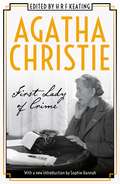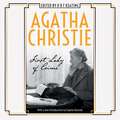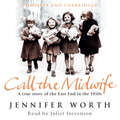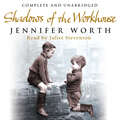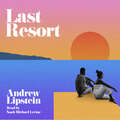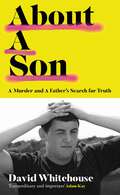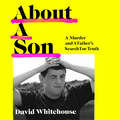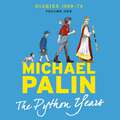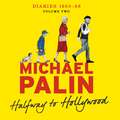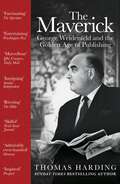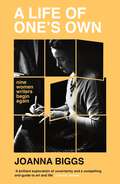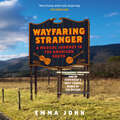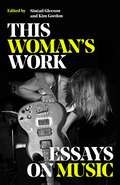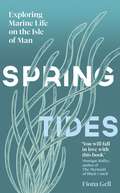- Table View
- List View
Agatha Christie: First Lady of Crime
by Agatha ChristieIncludes a new introduction from Sophie Hannah, bestselling author of THE MONOGRAM MURDERS and HAVEN'T THEY GROWNAgatha Christie was not only the biggest selling writer of detective stories the world has ever known, she was also a mystery in herself, giving only the rarest interviews, declining absolutely to become any sort of public figure, and a mystery too in the manner in which she achieved her astonishing success.H R F Keating, a crime novelist and respected reviewer of crime fiction, brought together a dozen distinguished writers from both sides of the Atlantic to throw light on this double mystery. Some analyse the art itself; some explain the reasons for her success, not just the books, but also in film and theatre.The approaches are penetrating, affectionate, enthusiastic, analytical, funny - even critical. Together, they give an almost unique insight into the life and work of the First Lady of Crime.
Agatha Christie: First Lady of Crime
by Agatha ChristieIncludes a new introduction from Sophie Hannah, bestselling author of THE MONOGRAM MURDERS and HAVEN'T THEY GROWNAgatha Christie was not only the biggest selling writer of detective stories the world has ever known, she was also a mystery in herself, giving only the rarest interviews, declining absolutely to become any sort of public figure, and a mystery too in the manner in which she achieved her astonishing success.H R F Keating, a crime novelist and respected reviewer of crime fiction, brought together a dozen distinguished writers from both sides of the Atlantic to throw light on this double mystery. Some analyse the art itself; some explain the reasons for her success, not just the books, but also in film and theatre.The approaches are penetrating, affectionate, enthusiastic, analytical, funny - even critical. Together, they give an almost unique insight into the life and work of the First Lady of Crime.
Medical Grade Music
by Steve Davis Kavus TorabiThe story of two outsiders and obsessives whose collision prompted an evangelistic alliance on the furthest frontiers of underground music.Steve Davis first met Kavus Torabi - guitarist with Gong, Guapo, Cardiacs and Knifeworld - in the mid-2000's at a gig by French underground rock legends Magma. Over the next few years, this unlikely duo's shared affinity for visionary psychedelic music would become the foundation of not only a firm friendship, but also the most infectiously inclusive broadcasting style since the much-mourned death of John Peel. In their weekly radio shows and a one-of-a-kind live DJ roadshow which included a legendary appearance at Glastonbury, Steve and Kavus mapped out a musical landscape of rare enchantment, where the only passport needed was a pair of open ears. No-one, least of all Davis and Torabi themselves, was expecting the 6-time former World Snooker champion and a British-Iranian underground rock musician to become one of the most trusted brands in British alternative music.As Steve and Kavus were starting to get to grips with the challenge of their newfound status, events took a further unexpected turn. Suddenly they found themselves in a band together. And not just any band ... as two thirds of Britain's (if not the world's) leading harmonium, guitar and analogue synth power-trio (with Michael J.York of Coil)The Utopia Strong, the two friends found themselves plunging into a vortex of spontaneous compositional excitement. How Steve and Kavus pulled this off is just one of the many questions MEDICAL GRADE MUSIC will try to answer. Part sonic memoir, part Socratic dialogue, part gonzo mission to the heart of what makes music truly psychedelic this book is the first work of joint autobiography to ever trace the evolution of a life-changing friendship through the discographies of Gentle Giant and Voivod. From the chip-shops of Plumstead to the the wildest shores of Plymouth's nineties thrash scene. it's a funny and fearless buddy movie of the soul, with a soundtrack that will make your eyes bleed.
Jane Austen (LIVES #6)
by Carol ShieldsBestselling, award-winning novelist writing about one of the most popular and enduring English novelists of all time.'Splendid ... a gem' LITERARY REVIEW'An excellent biography' MAIL ON SUNDAY'Shields on Austen offers up a delicious prospect. And we are not disappointed' SCOTSMANJane Austen was one of the world's most remarkable writers, whose characters are as alive today as they were two hundred years ago. Despite being one of the most perceptive writers about people and relationships, she never married and always lived with her parents and sister Cassandra.Perhaps unusual for women at that time, Jane Austen was acutely aware of the larger political and social world around her, but chose to focus her novels on the family as a microcosm through which to explore human nature.The prizewinning novelist Carol Shields gives us a beautifully written, perceptive look at the life of one of the finest and most popular English novelists of all time.
Charles Dickens (LIVES #4)
by Jane SmileySuperb, highly accessible biography of one of the giants of English literature by the Pulitzer Prize-winning author of A THOUSAND ACRES'Engaging and stimulating' Simon Callow'Jane Smiley, in her admirable contribution to Weidenfeld's series of short biographies, deals briskly with Dickens's career and works, and treats with sympathy and sense his relations with the women in his life' LITERARY REVIEWFrom a bitter and poverty-stricken childhood to a career as the most acclaimed and best loved writer in the English-speaking world, Charles Dickens had a life as full of incident as any of those he created in his novels of life in Victorian England. The enormous quantity of work, his public readings and his difficult relationships has made him a figure of enduring fascination. In this biography Jane Smiley reveals Charles Dickens as his contemporaries would have done, getting to know him more intimately than ever before. At the same time Smiley offers interpretations of almost all of Dickens' major works, showing how 'his novels shaped his life as much as his life shaped his novels'.
Virginia Woolf (LIVES #16)
by Nigel Nicolson MBE'You cannot find peace by avoiding life' Virginia WoolfAn intimate portrait of Virginia, the best-known and most influential Bloomsbury author of them all - 'All you need to know about the modernist, feminist icon' TIME OUT'A gem' SUNDAY TIMES'As a short introduction to Virginia Woolf this deceptively brief book could hardly be bettered and achieves high status instantly as a significant work of reference in its own right' THE TIMESVirginia Woolf was undoubtedly one of the literary giants of the twentieth century. She was a central figure in the Bloomsbury Group, and her writings were works of astonishing originality. Nigel Nicolson is the son of Vita Sackville-West, who was Virginia Woolf's most intimate friend, and for a short time her lover. He spent many days in her company and he has threaded his recollections of her throughout this unique narrative of her life.
Call The Midwife: A True Story Of The East End In The 1950s
by Jennifer WorthJennifer Worth's tales of being a midwife in 1950s London, now a major BBC TV series.Jennifer Worth came from a sheltered background when she became a midwife in the Docklands in the 1950s. The conditions in which many women gave birth just half a century ago were horrifying, not only because of their grimly impoverished surroundings, but also because of what they were expected to endure. But while Jennifer witnessed brutality and tragedy, she also met with amazing kindness and understanding, tempered by a great deal of Cockney humour. She also earned the confidences of some whose lives were truly stranger, more poignant and more terrifying than could ever be recounted in fiction. Attached to an order of nuns who had been working in the slums since the 1870s, Jennifer tells the story not only of the women she treated, but also of the community of nuns (including one who was accused of stealing jewels from Hatton Garden) and the camaraderie of the midwives with whom she trained. Funny, disturbing and incredibly moving, Jennifer's stories bring to life the colourful world of the East End in the 1950s.
Shadows Of The Workhouse: The Drama Of Life In Postwar London
by Jennifer WorthA fascinating slice of East End life, from the No.1 bestsellilng author of CALL THE MIDWIFE, soon to be a major BBC TV series.In this follow up to CALL THE MIDWIFE, Jennifer Worth, a midwife working in the docklands area of East London in the 1950s tells more stories about the people she encountered. There's Jane, who cleaned and generally helped out at Nonnatus House - she was taken to the workhouse as a baby and was allegedly the illegitimate daughter of an aristocrat. Peggy and Frank's parents both died within 6 months of each other and the children were left destitute. At the time, there was no other option for them but the workhouse. The Reverend Thornton-Appleby-Thorton, a missionary in Africa, visits the Nonnatus nuns and Sister Julienne acts as matchmaker. And Sister Monica Joan, the eccentric ninety-year-old nun, is accused of shoplifting some small items from the local market. She is let off with a warning, but then Jennifer finds stolen jewels from Hatton Garden in the nun's room. These stories give a fascinating insight into the resilience and spirit that enabled ordinary people to overcome their difficulties.
Last Resort
by Andrew Lipstein'So horribly delicious that the reader won't even dream of looking away'LitHub, Most Anticipated Books of 2022'If Less by Andrew Sean Greer left a hole in your life, good news: Last Resort will fill it. Fast and funny, it feels like a backstage pass to the book world'Meg Mason, author of Sorrow and Bliss'Fun and witty... Caleb Horowitz is exactly the kind of character I love to hate: self-justifying but reflective, self-centred but loving'Claire Fuller, Costa Novel Award winner of Unsettled Ground'Last Resort is one of those novels about writing guaranteed to make every novelist who reads it blush with its unsparing portrayal of greed, obsession and smug superiority. Wickedly funny: I loved it'Patrick Gale, author of Mother's Boy'A brilliant take on what it means to be an artist in a world of endless compromises. Look out, Faust, there's a new sheriff in town'Gary Shteyngart, author of Absurdistan and Lake Success'I finished it in a day'Nell Zink, author of Doxology'Last Resort is a strange and beguiling book about the contrivances, connivances and mysteries of creation, with an especially visceral depiction of male anxiety and an absolutely blistering end. A terrific debut'Joshua Ferris, author of Then We Came to the End'A propulsive tale of American literary ambition... A keenly observed and sharp-witted debut that's assured from first page to last'Tom Rachman, author of The ImperfectionistsWhen a bestseller-to-be cuts too close to reality, its author must make a Faustian bargain - both on the page and in real life Caleb Horowitz is twenty-seven, and his wildest dreams are about to come true. His manuscript has caught the attention of the literary agent, who offers him fame, fortune and a taste of the literary life. He can't wait for his book to be shopped around to every editor in New York, except one: Avi Dietsch, a college rival and the novel's 'inspiration.'When Avi gets his hands on the manuscript, he sees nothing but theft - and opportunity. And so Caleb is forced to make a Faustian bargain, one that tests his theories of success, ambition and the limits of art. A blazing debut novel blurring the lines of fact and fiction: a thrilling story of fame, fortune, and impossible choices.
Last Resort: A New York Times Editor’s Pick
by Andrew LipsteinCaleb Horowitz is twenty-seven, and his wildest dreams are about to come true. His manuscript has caught the attention of the literary agent, who offers him fame, fortune and a taste of the literary life. He can't wait for his book to be shopped around to every editor in New York, except one: Avi Dietsch, a college rival and the novel's 'inspiration.' <p><p>When Avi gets his hands on the manuscript, he sees nothing but theft - and opportunity. And so Caleb is forced to make a Faustian bargain, one that tests his theories of success, ambition and the limits of art.
Andy Warhol: A Biography (LIVES #2)
by Wayne Koestenbaum'Properly analytical ... always entertaining' TIME OUT'Should tempt both those generally familiar with Andy Warhol and, even more, young people who have trouble imagining how popular art can challenge the status quo' L A TIMESPainter, filmmaker, photographer, philosopher, all-round celebrity, Andy Warhol is an outstanding cultural icon. He revolutionised art by bringing to it images from popular culture - such as the Campbell's soup can and Marilyn Monroe's face - while his studio, the Factory, where his free-spirited cast of 'superstars' mingled with the rich and famous, became the place of origin for every groundswell shaping American culture.In many ways he can be seen as the precursor to today's 'celebrity artists' such as Tracey Emin and Damian Hurst. But what of the man behind the white wig and dark glasses? Koestenbaum gives a fascinating, revealing and thought-provoking picture of pop art's greatest icon.
About A Son: A Murder and A Father’s Search for Truth
by David Whitehouse'The book that everyone will be talking about this year: a staggering work of honesty, empathy and humanity, wholly unlike anything else you will have read' Terri WhiteOn the evening of Halloween in 2015, Morgan Hehir was walking with friends close to Nuneaton town centre when they were viciously attacked by a group of strangers. Morgan was stabbed, and died hours later in hospital. He was twenty years old and loved making music with his band, going to the football with his mates, having a laugh; a talented graffiti artist who dreamed of moving away and building a life for himself by the sea.From the moment he heard the news, Morgan's father Colin Hehir began to keep an extraordinary diary. It became a record not only of the immediate aftermath of his son's murder, but also a chronicle of his family's evolving grief, the trial of Morgan's killers, and his personal fight to unravel the lies, mistakes and cover-ups that led to a young man with a history of violence being free to take Morgan's life that night.Inspired by this diary, About a Son is a unique and deeply moving exploration of love and loss and a groundbreaking work of creative non-fiction. Part true crime, part memoir, it tells the story of a shocking murder, the emotional repercussions, and the failures that enabled it to take place. It shows how grief affects and changes us, and asks what justice means if the truth is not heard. It asks what can be learned, and where we go from here.
About A Son: A Murder and A Father’s Search for Truth
by David WhitehouseAs heard on the HOW TO FAIL podcast with Elizabeth Day'I was utterly floored by the emotional depth of About A Son - a book that reaches so deeply into the human experience that to read it is to be forever changed. It is an unflinching examination of grief, a painstaking deconstruction of injustice and a dispatch from the frontiers of the human heart' Elizabeth DayOn the evening of Halloween in 2015, Morgan Hehir was walking with friends close to Nuneaton town centre when they were viciously attacked by a group of strangers. Morgan was stabbed, and died hours later in hospital. He was twenty years old and loved making music with his band, going to the football with his mates, having a laugh; a talented graffiti artist who dreamed of moving away and building a life for himself by the sea.From the moment he heard the news, Morgan's father Colin Hehir began to keep an extraordinary diary. It became a record not only of the immediate aftermath of his son's murder, but also a chronicle of his family's evolving grief, the trial of Morgan's killers, and his personal fight to unravel the lies, mistakes and cover-ups that led to a young man with a history of violence being free to take Morgan's life that night.Inspired by this diary, About a Son is a unique and deeply moving exploration of love and loss and a groundbreaking work of creative non-fiction. Part true crime, part memoir, it tells the story of a shocking murder, the emotional repercussions, and the failures that enabled it to take place. It shows how grief affects and changes us, and asks what justice means if the truth is not heard. It asks what can be learned, and where we go from here.
Busy Being Free: A Lifelong Romantic is Seduced by Solitude
by Emma Forrest'A staggering piece of writing' Nigella Lawson'It's woken me up' Minnie Driver, author of Managing Expectations'The most delicious memoir that kept me in bed all day' Sophie Heawood, author of The Hungover GamesWhat happens when your story doesn't end the way you thought it would? When the dream life you have been working towards becomes something you must walk away from? When you swap a Hollywood marriage and a LA mansion with waterside views, for a little attic flat shared only with your daughter, beneath the star-filled sky of deepest North London? When you find yourself not lonely, but elated - elated to be alone with yourself, who you genuinely thought you might never get to see again? When, after a life guided by romantic obsession, you decide to turn your back not only on marriage, but all romantic and sexual attachments?
Busy Being Free: A Lifelong Romantic is Seduced by Solitude
by Emma Forrest'A staggering piece of writing' Nigella Lawson'It's woken me up' Minnie Driver, author of Managing Expectations'The most delicious memoir that kept me in bed all day' Sophie Heawood, author of The Hungover GamesWhat happens when your story doesn't end the way you thought it would? When the dream life you have been working towards becomes something you must walk away from? When you swap a Hollywood marriage and a LA mansion with waterside views, for a little attic flat shared only with your daughter, beneath the star-filled sky of deepest North London? When you find yourself not lonely, but elated - elated to be alone with yourself, who you genuinely thought you might never get to see again? When, after a life guided by romantic obsession, you decide to turn your back not only on marriage, but all romantic and sexual attachments?
About A Son: A Murder and A Father’s Search for Truth
by David WhitehouseAs heard on the HOW TO FAIL podcast with Elizabeth Day'I was utterly floored by the emotional depth of About A Son - a book that reaches so deeply into the human experience that to read it is to be forever changed. It is an unflinching examination of grief, a painstaking deconstruction of injustice and a dispatch from the frontiers of the human heart' Elizabeth DayOn the evening of Halloween in 2015, Morgan Hehir was walking with friends close to Nuneaton town centre when they were viciously attacked by a group of strangers. Morgan was stabbed, and died hours later in hospital. He was twenty years old and loved making music with his band, going to the football with his mates, having a laugh; a talented graffiti artist who dreamed of moving away and building a life for himself by the sea.From the moment he heard the news, Morgan's father Colin Hehir began to keep an extraordinary diary. It became a record not only of the immediate aftermath of his son's murder, but also a chronicle of his family's evolving grief, the trial of Morgan's killers, and his personal fight to unravel the lies, mistakes and cover-ups that led to a young man with a history of violence being free to take Morgan's life that night.Inspired by this diary, About a Son is a unique and deeply moving exploration of love and loss and a groundbreaking work of creative non-fiction. Part true crime, part memoir, it tells the story of a shocking murder, the emotional repercussions, and the failures that enabled it to take place. It shows how grief affects and changes us, and asks what justice means if the truth is not heard. It asks what can be learned, and where we go from here.
The Python Years: Diaries 1969-1979 Volume One
by Michael PalinMichael Palin's bestselling diaries before, during and after Monty Python.Michael Palin's diaries begin when he was newly married and struggling to make a name for himself in the world of television comedy. But Monty Python was just around the corner . . .Enjoying an unlikely cult status early on, the Pythons then proceeded to tour the USA and Canada. As their popularity grew, so Palin relates how the group went their separate ways, later to re-form for stage shows and the celebrated films THE HOLY GRAIL and LIFE OF BRIAN. Living through the three-day week and the miners strike, and all the trials of a peripatetic life are also essential ingredients of these perceptive and funny diaries.
Halfway To Hollywood: Diaries 1980-1988 (Volume Two)
by Michael PalinMichael Palin's bestselling diaries of the 1980s.After a live performance at the Hollywood Bowl, The Pythons made their last performance together in 1983 in the hugely successful MONTY PYTHON'S MEANING OF LIFE. Writing and acting in films and television then took over much of Michael's life, culminating in the smash hit A FISH CALLED WANDA (for which he won a BAFTA for Best Supporting Actor), and the first of his seven celebrated television journeys for the BBC. He co-produced, wrote and played the lead in THE MISSIONARY opposite Maggie Smith, who also appeared with him in A PRIVATE FUNCTION, written by Alan Bennett. Such was his fame in the US, he was enticed into once again hosting the enormously popular show Saturday Night Live, in one edition of which his mother makes a highly successful surprise guest appearance. He filmed several journeys for television and became chairman of the pressure group, Transport 2000. His family remains a constant as his and Helen's children enter their teens.
The Maverick: George Weidenfeld and the Golden Age of Publishing
by Thomas HardingBorn into a Jewish family in Vienna in 1919, George Weidenfeld fled to England in 1938 to escape the Nazi regime. There he began a career in publishing that would make him one of the most influential figures in the industry. Over the course of his long and illustrious career he championed some of the most important voices of the twentieth century, from Vladimir Nabokov, Mary McCarthy and Saul Bellow to Harold Wilson, Isaiah Berlin and Henry Kissinger.But what do we know about the man himself? Was he, as described by some, the 'greatest salesperson', 'the world's best networker', 'the publisher's publisher' and 'a great intellectual'? Was his lifelong effort to be the world's most famous host a cover for his desperate loneliness? Who, in fact, was the real George Weidenfeld and how did he rise so successfully within the ranks of London and New York society? Providing a full, unvarnished and at times difficult history of this complex man, this first biography of a titan of culture is also a story of resilience, determination and the power of ideas to shape history.
A Life of One's Own: Nine Women Writers Begin Again
by Joanna BiggsI took off my wedding ring - a gold band with half a line of 'Morning Song' by Sylvia Plath etched inside - and for weeks afterwards, my thumb would involuntarily reach across my palm for the warm bright circle that had gone. I didn't throw the ring into the long grass, like women do in the movies, but a feeling began bubbling up nevertheless, from my stomach to my throat: it could fling my arms out. I was free.A few years into her marriage and feeling societal pressure to surrender to domesticity, Joanna Biggs found herself longing for a different kind of existence. Was this all there was? She divorced without knowing what would come next.Newly untethered, Joanna returned to the free-spirited writers of her youth and was soon reading in a fever - desperately searching for evidence of lives that looked more like her own, for the messiness and freedom, for a possible blueprint for intellectual fulfillment.In A Life of One's Own, Mary Wollstonecraft, George Eliot, Zora Neale Hurston, Virginia Woolf, Simone de Beauvoir, Sylvia Plath, Toni Morrison, and Elena Ferrante are all taken down from their pedestals, their work and lives seen in a new light. Joanna wanted to learn more about the conditions these women needed to write their best work, and how they addressed the questions she herself was struggling with: Is domesticity a trap? Is life worth living if you have lost faith in the traditional goals of a woman? Why is it so important for women to read one another?This is a radical and intimate examination of the unconventional paths these women took - their pursuits and achievements but also their disappointments and hardships. And in exploring the things that gave their lives the most meaning, we find fuel for our own singular intellectual paths.
My Unapologetic Diaries
by Joan Collins'Wonderfully rich and mesmerising' William Boyd'As brutal, withering and funny as you'd expect' Julian Clary'Fabulously entertaining, impossibly glamorous, and utterly irresistible' Piers Morgan'A treat from start to finish' Elizabeth Hurley***Joan Collins has been a diarist from the age of twelve, writing enthusiastically over the years. She dictated most of these entries in real time into a mini-tape recorder at the end of the day, and now she is spilling the beans - well, nearly all of them. What you will discover was written when Joan 'felt like it' between 1989 and 2009. Whether it is an encounter with a superstar or a member of the Royal Family, or her keen and honest insights into other celebrities at dinner parties and events, Joan is honest and unapologetic.Taking us on a dazzling tour around the globe - from exclusive restaurants in Los Angeles to the glittering beaches of St Tropez, from dinner parties in London to galas in New York City - some of the characters you will meet in these pages include Rod Stewart, Princess Margaret, Donald Trump, Michael Caine, Princess Diana, Elizabeth Taylor, Rupert Everett, Roger Moore, Shirley MacLaine, Andrew Lloyd Webber and many more. Her diaries are intimate and witty, and they pull no punches, with NO apologies to anyone mentioned in them!
Wayfaring Stranger: A Musical Journey in the American South
by Emma JohnCan you feel nostalgic for a life you've never known?Suffused with her much-loved warmth and wit, Emma John's memoir follows her moving and memorable journey to master one of the hardest musical styles on earth - and to find her place in an alien world.Emma had fallen out of love with her violin when a chance trip to the American South introduced her to bluegrass music. Classically trained, highly strung and wedded to London life, Emma was about as country as a gin martini. So why did it feel like a homecoming?Answering that question takes Emma deep into the Appalachian mountains, where she uncovers a hidden culture that confounds every expectation - and learns some emotional truths of her own.
This Woman's Work: Essays on Music
by VariousThis Woman's Work: Essays on Music is edited by Kim Gordon and Sinéad Gleeson and features contributors Anne Enright, Fatima Bhutto, Jenn Pelly, Rachel Kushner, Juliana Huxtable, Leslie Jamison, Liz Pelly, Maggie Nelson, Margo Jefferson, Megan Jasper, Ottessa Moshfegh, Simone White, Yiyun Li and Zakia Sewell.Published to challenge the historic narrative of music and music writing being written by men, for men, This Woman's Work seeks to confront the male dominance and sexism that have been hard-coded in the canons of music, literature, and film and has forced women to fight pigeon-holing or being side-lined by carving out their own space. Women have to speak up, to shout louder to tell their story - like the auteurs and ground-breakers featured in this collection, including: Anne Enright on Laurie Anderson; Megan Jasper on her ground-breaking work with Sub Pop; Margo Jefferson on Bud Powell and Ella Fitzgerald; and Fatima Bhutto on music and dictatorship.This Woman's Work also features writing on the experimentalists, women who blended music and activism, the genre-breakers, the vocal auteurs; stories of lost homelands and friends; of propaganda and dictatorships, the women of folk and country, the racialised tropes of jazz, the music of Trap and Carriacou; of mixtapes and violin lessons.
Spring Tides: Exploring Marine Life on the Isle of Man
by Fiona Gell'This is my earliest memory. I am three years old and I sit in the bottom of my great-uncle's pot boat and take off the bands from the lobsters' claws. The deepest of blues, they creak over the bilges with robotic limbs towards my father's bare feet as he rows. Over the scent of the herring bait I can smell the fresh, sweet smell of wrack on the shore. This book has come out of over twenty years of studying the sea and trying to protect it, and a lifetime of loving our other world beneath waves.'In Spring Tides, marine biologist Fiona Gell tells the story of a pioneering project to create the very first marine nature reserve on the Isle of Man. Growing up in a traditional fishing family on the island, Fiona spent her time on her grandfather's boat, listening to stories from the local fishermen and combing the beach for mermaid's purses and whelks' eggs. She developed a lifelong love of the sea and Manx culture, and on her return to the island after twelve years away studying marine life, she led a three-year-long struggle to protect an area called Ramsey Bay and the precious emerald green eelgrass forests which grew there. With scientific insight and spellbinding prose she perfectly captures the wonder of island life, from the intricate beauty of bright pink maerl, to the enormity of giant basking sharks spotted off the cliffs of the bay. This beautiful story from a small island reveals the transformative power of the sea, and the importance of protecting it for future generations.
Wayward: Just Another Life to Live
by Vashti Bunyan'Magical and transporting . . . Wayward proves that Bunyan has lived the best possible life, on her own idiosyncratic terms'Maggie O'Farrell'A gorgeous account of outsiderness and survival: a map of how to live outside the boundaries and of striving for an authentic artistic life. A quietly defiant and moving work' Sinéad Gleeson'An epic in miniature . . . I loved - and lived - every sentence' Benjamin MyersIn 1968, Vashti Bunyan gave up everything and everybody she knew in London to take to the road with a horse, wagon, dog, guitar and her then partner. They made the long journey up to the Outer Hebrides in an odyssey of discovery and heartbreak, full of the joy of freedom and the trudge of everyday reality, sleeping in the woods, fighting freezing winters and homelessness. Along the way, Vashti wrote the songs that would lead to the recording of her 1970's album Just Another Diamond Day, the lilting lyrics and guitar conveying innocent wonder at the world around her, whilst disguising a deeper turmoil under the surface. From an unconventional childhood in post-war London, to a fledgling career in mid-sixties pop - recording a single written by Mick Jagger and Keith Richards - to the despair and failure to make any headway with her own songs, she rejected the music world altogether and left it all behind. After retreating to a musical wilderness for thirty years, the rediscovery of her recordings in 2000 brought Vashti a second chance to write, record and perform once more. One of the great hippie myths of the 1960s, Wayward, Just Another Life to Live, rewrites the narrative of a barefoot girl on the road to describe a life lived at full tilt from the first, revealing what it means to change course and her emotional struggle, learning to take back control of her own life.
